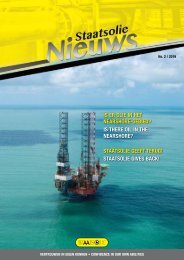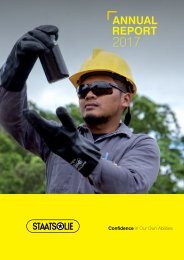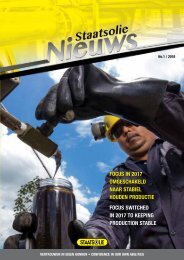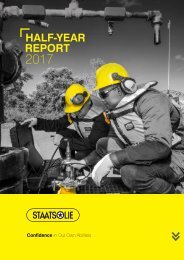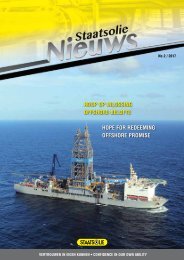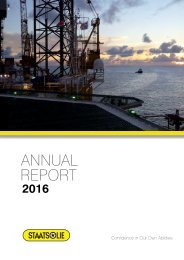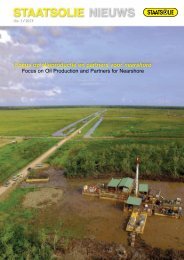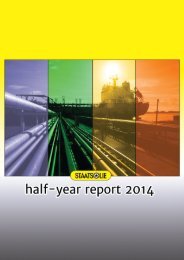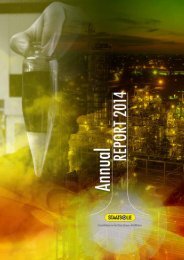Staatsolie Nieuws January 2019
You also want an ePaper? Increase the reach of your titles
YUMPU automatically turns print PDFs into web optimized ePapers that Google loves.
UPSTREAM<br />
WATERHYACINT ZORGT VOOR VEEL OVERLAST<br />
WATER HYACINTH CAUSES A LOT OF INCONVENIENCE<br />
Met haar paarsachtige bloemen vormt de waterhyacint in eerste oogopslag een<br />
prachtig decor voor een natuurfilm. Kilometers uitgestrekt ligt de plant als een<br />
groene deken op het wateroppervlak van de zwampen in de Tambaredjo-Noordwest<br />
(TNW) en Calcutta productiegebieden.<br />
With its purplish flowers the water hyacinth is at first glance a beautiful backdrop<br />
for a nature film. For miles the plant stretches like a green blanket on the water<br />
surface in the swamps of the Tambaredjo North West (TNW) and the Calcutta areas.<br />
De Waterhyacinth,<br />
niet te omzeilen in<br />
het zwampgebied.<br />
There is no getting<br />
around the<br />
Waterhyacinth in the<br />
swamps.<br />
De waterhyacint is een hardnekkige parasiet die zich niet makkelijk laat bestrijden.<br />
De plant is rond 2011 ontdekt in de zwampen waar <strong>Staatsolie</strong> productieactiviteiten<br />
ontplooid. “Deze waterplant is vermoedelijk door materieel dat in<br />
andere gebieden werd ingezet, in de zwamp terecht gekomen”, vertelt Anette Schuitemaker,<br />
manager TNW/Calcutta Operations.<br />
In rap tempo heeft de waterhyacint zich in het gehele gebied verspreid en zorgt voor<br />
veel overlast. Vaargeulen raken dichtbegroeid, waardoor de toegang tot bronnen en<br />
andere productiefaciliteiten wordt bemoeilijkt. Inspecties van deze productiefaciliteiten<br />
in die delen van de zwampen, kunnen dan uitsluitend met de airboat (moerasboot)<br />
worden uitgevoerd. Dit brengt met zich mee dat moerasboten meer kracht nodig hebben<br />
om over waterhyacinten te gaan door de grotere wrijving. Het gevolg is snellere<br />
slijtage van motoren en andere cruciale onderdelen. “De airboat raakt dan eerder<br />
defect en het brandstofverbruik is door deze omstandigheden hoog”, benadrukt Anette.<br />
Ook voor het leven in de zwamp heeft de waterhyacint nadelige gevolgen. Door de<br />
dichte begroeiing belemmert het de zonnestralen om de bodem van de zwamp te<br />
bereiken, wat dan weer van grote invloed is op het aquatisch leven. Tot nu toe wordt<br />
de waterplant, die vrij agressief groeit, regelmatig met graafmachines verwijderd uit de<br />
vaargeulen. Het open houden van de waterwegen kost <strong>Staatsolie</strong> per jaar ongeveer<br />
SRD 2 miljoen.<br />
Bio-energie<br />
<strong>Staatsolie</strong> wil de overlast duurzaam oplossen. Samen met de Anton de Kom Universiteit<br />
van Suriname wordt hiertoe in <strong>2019</strong> een project gestart, waarbij onder andere<br />
mogelijkheden zullen worden bestudeerd om bio-energie te produceren uit de waterhyacint.<br />
Maar eerst zal de universiteit de haalbaarheid van deze optie nagaan. Indien<br />
opwekking van bio-energie uit de waterhyacint haalbaar is, zal ook worden nagegaan<br />
hoe die energie uiteindelijk aan te kunnen wenden voor de bedrijfsoperaties.<br />
The water hyacinth is a stubborn parasite that cannot easily be<br />
destroyed. The plant is discovered around 2011 in the swamps<br />
where <strong>Staatsolie</strong> operates. “This water plant probably ended up<br />
in the swamp by material that was used on other locations”, said<br />
Anette Schuitemaker, TNW/Calcutta Operations manager.<br />
The water hyacinth has rapidly spread throughout the area and<br />
causes a lot of inconvenience. The fairway becomes dense,<br />
making access to wells and other production facilities difficult.<br />
Inspections of these production facilities in those parts of the<br />
swamps can then only be carried out with the airboat. The disadvantage<br />
is that airboats need more power to cross over water<br />
hyacinths because of the greater friction. The result is faster wear<br />
of engines and other crucial parts. “The airboat is more likely to<br />
malfunction and fuel consumption is high because of these circumstances”,<br />
emphasizes Anette.<br />
Life in the swamp is also adversely affected by the water hyacinth.<br />
The dense growth prevents sunrays to reach the bottom of the<br />
swamp, which in turn has a major influence on aquatic life. Thus<br />
far, the lushly-growing water hyacinth is regularly removed from<br />
the fairways by excavators. This costs <strong>Staatsolie</strong> two million SRD<br />
annually.<br />
Bio energy<br />
<strong>Staatsolie</strong> wants to solve the nuisance sustainably. In cooperation<br />
with the Anton de Kom University of Suriname a joint project will<br />
be started in <strong>2019</strong> to study the feasibility of producing bio energy<br />
from the water hyacinth. The university will first examine the feasibility.<br />
If production of bio energy is possible, parties will determine<br />
how the energy can eventually be used for operation activities.<br />
De waterhyacint (Eichhornia crassipes) is een waterplant uit de pontederiafamilie<br />
(Pontederiaceae). De plant is afkomstig uit Zuid-Amerika. Elke bladvoet is verdikt<br />
tot een met lucht gevulde sponsachtige bol. Daardoor heeft de waterhyacint een<br />
groot drijfvermogen. De planten vermeerderen zowel door wortelstokken waaraan<br />
nieuwe planten gaan groeien, als door zaad. Zo kan de waterhyacint een ware<br />
plaag worden. De waterhyacint wordt op twee manieren bestreden:<br />
1. Mechanisch, hier worden de planten opgepakt en plat gemaakt.<br />
2. Biologisch, hier wordt op snuitkevers gedoeld die het specifiek<br />
op de waterhyacint voorzien hebben.<br />
<strong>Staatsolie</strong> <strong>Nieuws</strong> • No. 1 • <strong>2019</strong><br />
The water hyacinth (Eichhornia crassipes) is a water plant from the<br />
pontederia species (Pontederiaceae). The plant is endemic to South<br />
America. Each leaf base is thickened into an air-filled sponge-like<br />
sphere. As a result, the water hyacinth has a great buoyancy. The<br />
plants reproduce both through rhizomes from which new plants<br />
grow, and seeds. This allows water hyacinths to become a real<br />
scourge. There are two plant control methods for water hyacinths:<br />
1. Mechanically, the plants are rooted out and crushed.<br />
2. Organic, here we refer to snout beetles that specifically<br />
feed on the water hyacinth.<br />
7






